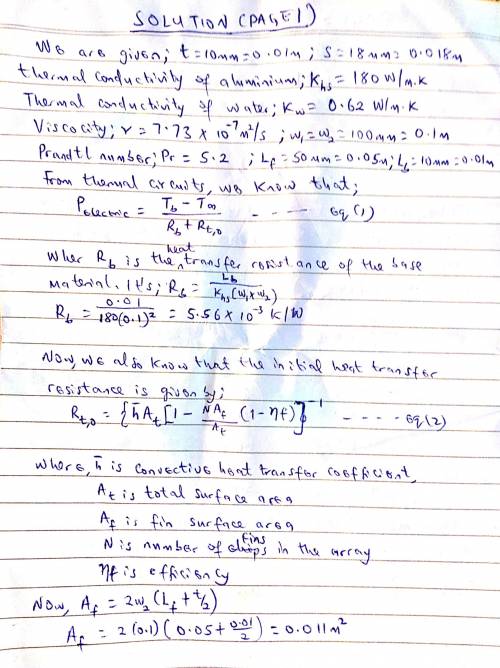
Engineering, 07.04.2020 01:05 xkxd13x
An array of electronic chips is mounted within a sealedrectangular enclosure, and colling is implemented by attaching analuminum heat sink (k=180 W/m*K). The base of the heat sinkhas dimensions of w1=w2=100mm, while the 6 fins are of thicknesst=10mm and pitch S=18mm. The fin length is Lf=50 mm, and thebase of the heat sink has a thickness of Lb=10mm.
If cooling is implemented by water flow through the heat sink, with u[infinity]=3 m/s and T[infinity]=17 C, what is the base temperatureTb of the heat sink when the power dissipation by the chips isPelec=1800W? The average convection coefficient for surfacesof the fins and the exposed base may be estimated by assumingparallel flow over a flat plate. Properties of the water maybe approximated as k=0.62 W/m*K, ν=7.73E-7 m2/s, andPr=5.2.

Answers: 1


Another question on Engineering

Engineering, 04.07.2019 18:10
Assuming compressible flow of air and that the measurements are done at flagstaff a pitot static tube that gives the difference of total and static pressure measures 0.35 m of mercury. what is the velocity of air? assume the temperature to be 300k. (submit your excel or matlab calculation sheet)
Answers: 1

Engineering, 04.07.2019 18:20
An engine runs on the ideal diesel cycle. the cycle has a compression ratio of 20 and a cutoff ratio of 2. the highest temperature in the cycle is 1200 k. if the heat into the system is 300 kj/kg of working fluid and using variable specific heats determine the work produced per mass of working fluid
Answers: 3

Engineering, 04.07.2019 19:10
Analyze the factors that influence the choice between the following pairs of processes to make the products indicated: i) sand casting versus die casting of an electric-motor housing ii) thread rolling versus machining of a bolt for high-strength application. (co3/c5)
Answers: 3

Engineering, 04.07.2019 19:20
At steady state, air at 200 kpa, 325 k, and mass flow rate of 0.5 kg/s enters an insulated duct having differing inlet and exit cross-sectional areas. the inlet cross-sectional area is 6 cm2. at the duct exit, the pressure of the air is 100 kpa and the velocity is 250 m/s. neglecting potential energy effects and modeling air as an 1.008 kj/kg k, determine ideal gas with constant cp = (a) the velocity of the air at the inlet, in m/s. (b) the temperature of the air at the exit, in k. (c) the exit cross-sectional area, in cm2
Answers: 2
You know the right answer?
An array of electronic chips is mounted within a sealedrectangular enclosure, and colling is impleme...
Questions

Mathematics, 10.12.2019 23:31








Mathematics, 10.12.2019 23:31




English, 10.12.2019 23:31

Mathematics, 10.12.2019 23:31


Mathematics, 10.12.2019 23:31

Mathematics, 10.12.2019 23:31

Mathematics, 10.12.2019 23:31







